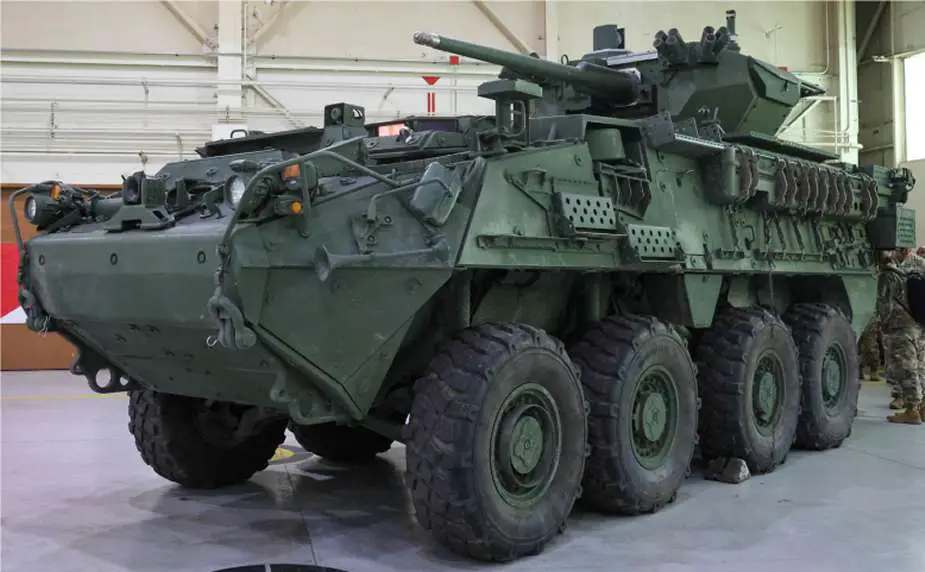On April 7, 2024, the 1-2 Stryker Brigade Combat Team (SBCT) hosted a demonstration for General George, the Chief of Staff of the US Army, and Sergeant Major of the Army Weimer. This event showcased the XM1304 Stryker Infantry Carrier Vehicle Double V Hull A1-30MM (ICVVA1-30MM), aiming to detail the capabilities and differences of the XM1304 compared to previous Stryker models such as the M1256A1 infantry carrier vehicle.
Follow Army Recognition on Google News at this link

The XM1304 Stryker Infantry Carrier Vehicle Double V Hull A1-30MM (ICVVA1-30MM) is equipped with the Samson Pro 30mm unmanned turret developed by Rafael and Oshkosh. (Picture source: 1-2 SBCT)
During the visit, Captain Shepket Tohti, Commander of Bronco Troop, 1st Squadron, 14th Cavalry Regiment "Warhorse", detailed the advancements of the Stryker Double V-Hull A1. The focus was on the integration of the Common Remotely Operated Weapon Station - Javelin (CROWS-J) platform and the vehicle's driver capabilities. The XM1304's maneuverability, speed, and targeting efficiency were highlighted, demonstrating its readiness and effectiveness for future large-scale combat scenarios against equivalent military forces.
The Stryker Double V-Hull (DVH) represents an evolution in the design and capabilities of the Stryker family of armored fighting vehicles used by the US Army. This evolution addresses operational challenges experienced by Stryker units, especially the threat of improvised explosive devices (IEDs) and roadside bombs in conflict areas like Iraq and Afghanistan. The Stryker DVH and its upgraded variant, the DVH A1, aim to enhance soldier safety and vehicle resilience while improving overall performance, survivability, and operational adaptability.
Central to the DVH design is its distinctive V-shaped hull, departing from the flat-bottomed hulls of the previous Stryker vehicles. This hull configuration draws inspiration from the survivability features of Mine-Resistant Ambush Protected (MRAP) vehicles, utilizing a pronounced V-shape to redirect blast forces from IEDs and mines away from the vehicle, thereby reducing harm to occupants. In addition to the V-hull, the Stryker DVH integrates advanced armor protection and blast-attenuating seats, further fortifying crew and passenger safety.
Key upgrades to the DVH A1 variants include a Mechanical Power Upgrade to a 450 horsepower Caterpillar C9 engine, an Electrical Power Upgrade to a 910 amp alternator for future network capabilities, a Chassis Upgrade increasing the gross vehicle weight rating (GVWR) to 63,000 pounds for enhanced payload capacity, and an In-Vehicle Network Architecture overhaul for better communication and data management.
The Stryker DVH A1 family comprises seven specialized variants designed for specific roles within brigade combat teams. These include the Anti-Tank Guided Missile Vehicle (ATVV-A1), Commander’s Vehicle (CVV-A1), Engineer Squad Vehicle (ESVV-A1), Fire Support Vehicle (FSVV-A1), Infantry Carrier Vehicle (ICVV-A1), Mortar Carrier Vehicle (MCVV-A1), and Medical Evacuation Vehicle (MEVV-A1). The ICVV-A1 variant, equipped with a scout Mission Equipment Package (MEP), replaces the reconnaissance vehicle variant in the DVH A1 lineup.
The XM1304 ICVVA1-30MM integrates the Samson Pro 30mm unmanned turret developed by Rafael and Oshkosh, part of the US Army's initiative to enhance armored capabilities. The turret, equipped with a fire-control system for efficient target engagement, supports various armaments including a 30/40mm cannon and a 7.62mm coaxial machine gun. Additional features include the Trophy Active Protection System (APS) and Spike LR anti-tank guided missiles, along with the XM813 cannon for programmable airburst ammunition.
The XM813 Bushmaster, an enhancement of the Mk44 30mm chain gun, improves firepower for vehicles like the M1126 Stryker and M2 Bradley. It features a longer barrel, an integral mount for increased hit probability, and a dual recoil system. The Meggitt linkless dual feed system accommodates Mk310 Programmable Air Burst Munition rounds, and with specific modifications, the caliber can increase to 40 mm.
















